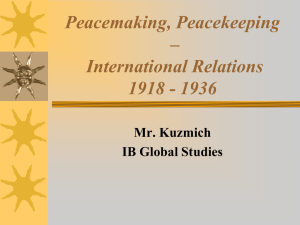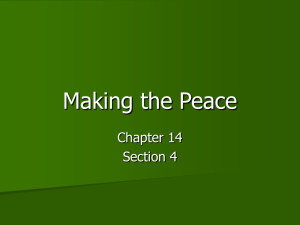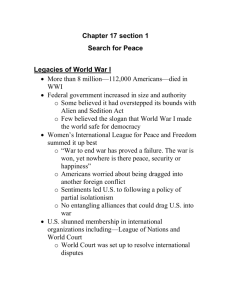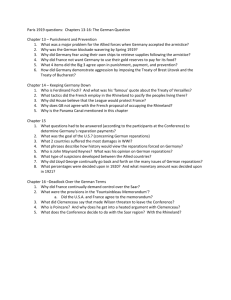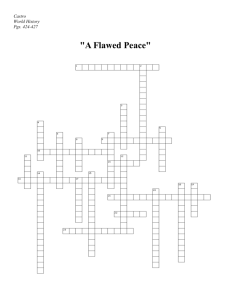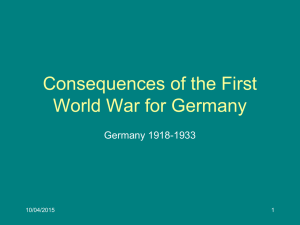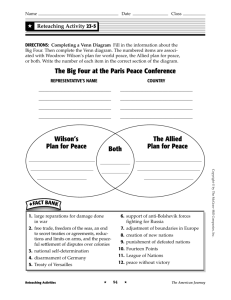Stresemann – strengthening or weakening the Weimar Republic
advertisement
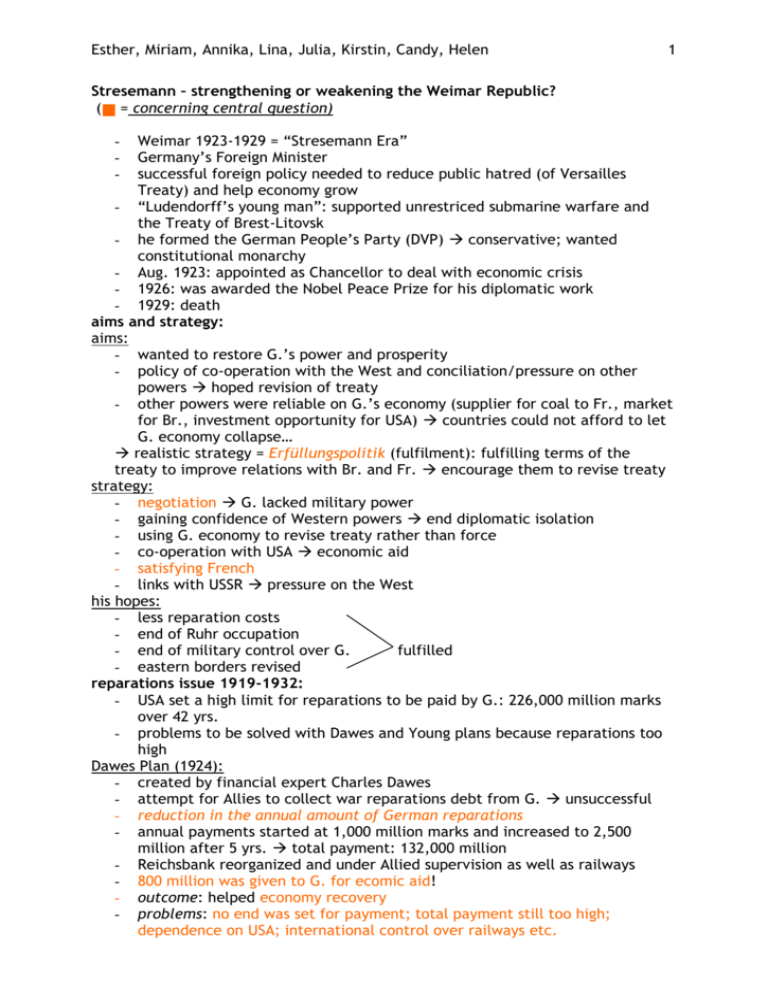
Esther, Miriam, Annika, Lina, Julia, Kirstin, Candy, Helen 1 Stresemann – strengthening or weakening the Weimar Republic? ( = concerning central question) - Weimar 1923-1929 = “Stresemann Era” Germany’s Foreign Minister successful foreign policy needed to reduce public hatred (of Versailles Treaty) and help economy grow “Ludendorff’s young man”: supported unrestriced submarine warfare and the Treaty of Brest-Litovsk he formed the German People’s Party (DVP) conservative; wanted constitutional monarchy Aug. 1923: appointed as Chancellor to deal with economic crisis 1926: was awarded the Nobel Peace Prize for his diplomatic work 1929: death and strategy: aims aims: - wanted to restore G.’s power and prosperity - policy of co-operation with the West and conciliation/pressure on other powers hoped revision of treaty - other powers were reliable on G.’s economy (supplier for coal to Fr., market for Br., investment opportunity for USA) countries could not afford to let G. economy collapse… realistic strategy = Erfüllungspolitik (fulfilment): fulfilling terms of the treaty to improve relations with Br. and Fr. encourage them to revise treaty strategy: - negotiation G. lacked military power - gaining confidence of Western powers end diplomatic isolation - using G. economy to revise treaty rather than force - co-operation with USA economic aid - satisfying French - links with USSR pressure on the West his hopes: - less reparation costs - end of Ruhr occupation - end of military control over G. fulfilled - eastern borders revised reparations issue 1919-1932: - USA set a high limit for reparations to be paid by G.: 226,000 million marks over 42 yrs. - problems to be solved with Dawes and Young plans because reparations too high Dawes Plan (1924): - created by financial expert Charles Dawes - attempt for Allies to collect war reparations debt from G. unsuccessful - reduction in the annual amount of German reparations - annual payments started at 1,000 million marks and increased to 2,500 million after 5 yrs. total payment: 132,000 million - Reichsbank reorganized and under Allied supervision as well as railways - 800 million was given to G. for ecomic aid! - outcome: helped economy recovery - problems: no end was set for payment; total payment still too high; dependence on USA; international control over railways etc. Esther, Miriam, Annika, Lina, Julia, Kirstin, Candy, Helen 2 Young Plan (1929) - programme for settlement of G. reparations debt presented by Owen Young - result of Dawes Plan because G. couldn’t meet huge annual payment - total payment reduced to 37,000 million marks - lower annual payment ove 58 yrs. - Allied supervision abrogated - outcome: Allied troops were withdrawn in 1930s - problems: internal opposition by nationalists arranged referendum on its acceptance (didn’t want to pay reparations at all) NSDAP wanted Freiheitsgesetz ("Liberty Law") to renounce all reparations (amongst others); the Young Plan collapsed with the coming of the Great Depression G. only paid 1/8 of original sum (paid in form of coal, manufactured goods and gold) Locarno Pact (1925) - seven agreements negotiated at Locarno/Switzerland between G., Br., Fr., Italy, Belgium - thought to secure post-war territorial settlement - divided orders in Europe into western borders (guaranteed by Locarno treaties) and eastern borders (open for revision) - G. reassured Fr.’s borders G. could concentrate on revision in east - outcome: all countries renounced use of invasion; G. also signed arbitration treaties with Poland and Czechoslovakia renouncing use of force improved western European climate; hope for international peace (“spirit of Locarno”) League of Nations (1926) - internationals organization founded as a result of Versailles Treaty - G. joined in 1926 and was given a veto power on League Council great power! - G. used its position to raise G. interest Treaty of Berlin (1926) - G. and USSR pledged neutrality in event of attack on the other by third country for the next 5 yrs. helped to develop good relations between these two countries Stresemann transformed G. from being a distrusted outcast to being actively involved in European diplomacy! Allied occupation (1924-1925) - Stresemann called off passive resistance Fr. withdraw from Ruhr - Young Plan: Allies withdraw completely in 1930 Disarmament - Stresemann wanted to address issue of disarmament - 1928: Kellog-Briand-Pact was signed with 70 other countries to renounce use of force to end war and create international peace ineffective… - 1926: minor success = Inter-Allied Military Control Commission was withdrawn - G. secretely rearmed Esther, Miriam, Annika, Lina, Julia, Kirstin, Candy, Helen Central question: PROs: (strength) - - - Erfüllungspolitik (negotiations) Dawes Plan (reduced reparations; 800 million loan economic recovery) Young Plan (reduced reparations again; Allied troops withdrwan) Locarno Pact (improved European climate) League of Nations (great power to G.) Treaty of Berlin (G. involved in European diplomacy) Allied occupation (no passive resistance anymore) Kellog-Briand-Pact (renounced use of force) CONs: (weakness) - - Dawes Plan (reparations still too high; dependence on USA) Young Plan (international opposition) League of Nations (too much power for G. fear for other countries) Kellog-Briand-Pact failed 3


